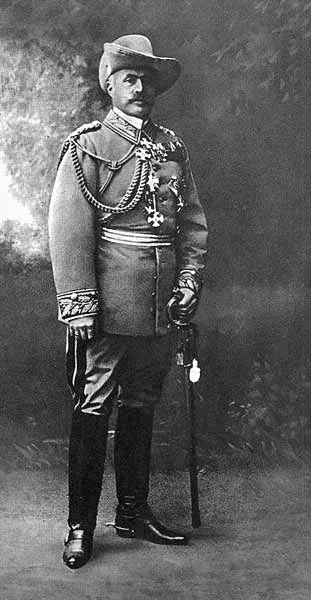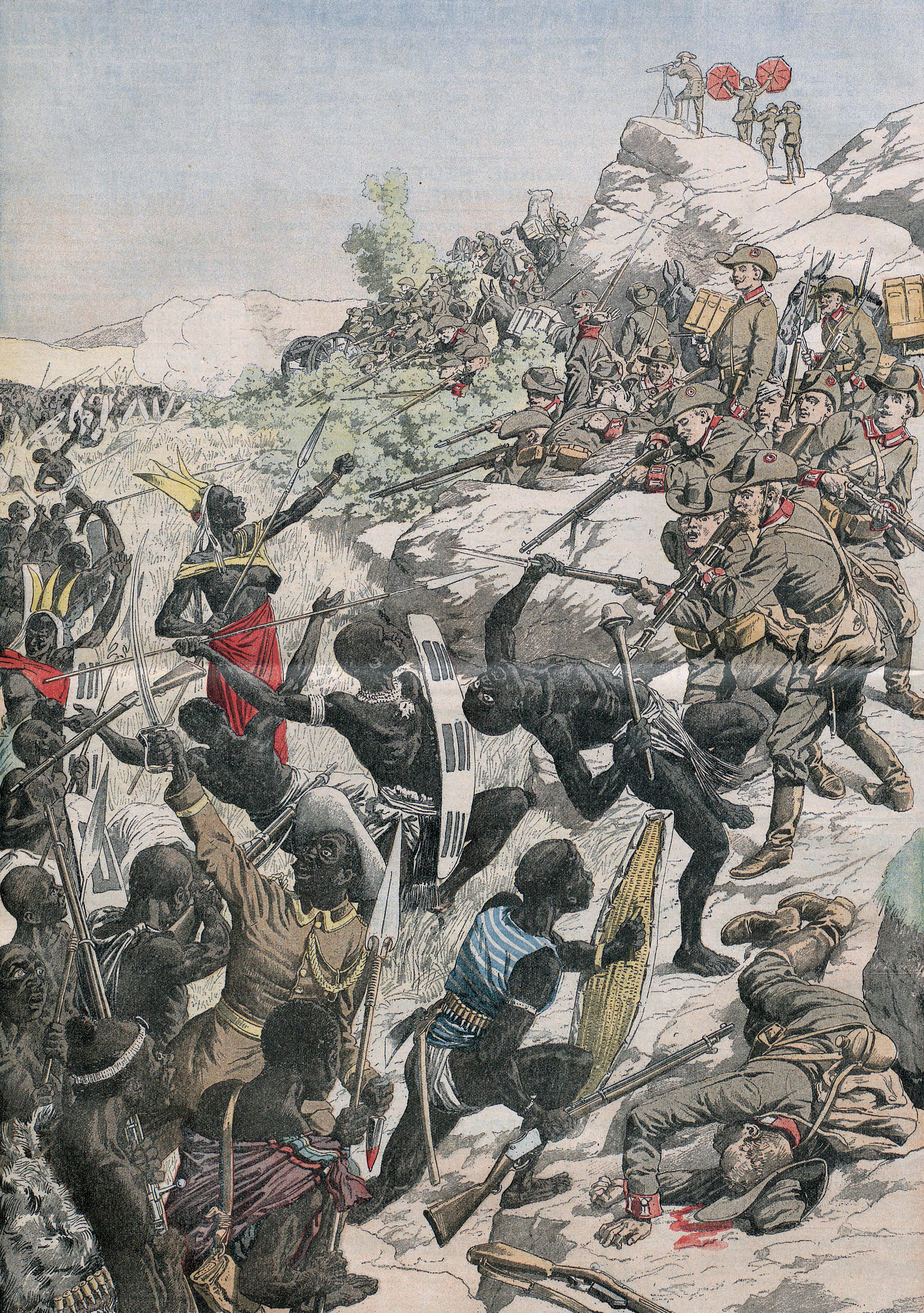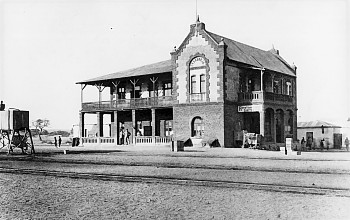|
Herero And Namaqua Genocide
The Herero and Namaqua genocide or the Herero and Nama genocide was a campaign of ethnic extermination and collective punishment waged by the German Empire against the Herero (Ovaherero) and the Nama in German South West Africa (now Namibia). It was the first genocide of the 20th century, occurring between 1904 and 1908. In January 1904, the Herero people, who were led by Samuel Maharero, and the Nama people, who were led by Captain Hendrik Witbooi, rebelled against German colonial rule. On January 12, they killed more than 100 German settlers in the area of Okahandja, although women, children, missionaries and non-German Europeans were spared. In August, German General Lothar von Trotha defeated the Ovaherero in the Battle of Waterberg and drove them into the desert of Omaheke, where most of them died of dehydration. In October, the Nama people also rebelled against the Germans, only to suffer a similar fate. Between 24,000 and 100,000 Hereros and 10,000 Nama died ... [...More Info...] [...Related Items...] OR: [Wikipedia] [Google] [Baidu] |
Herero Wars
The Herero Wars were a series of colonial wars between the German Empire and the Herero people of German South West Africa (present-day Namibia). They took place between 1904 and 1908. Background Pre-colonial South-West Africa The Hereros were cattle grazers, occupying most of central and northern South West Africa. Under the leadership of Jonker Afrikaner, who died in 1861, and then later under the leadership of Samuel Maharero, they had achieved supremacy over the Nama and Orlam peoples in a series of conflicts that had in their later stages, seen the extensive use of fire-arms obtained from European traders. German colonization In the early 1880s, the German statesman Otto von Bismarck, reversing his previous rejection of colonial acquisitions, decided on a policy of imperial expansion. In 1882 Bismarck gave permission to Adolf Lüderitz to obtain lands which Germany would bring within its "protection", under the conditions that a port was established within the terri ... [...More Info...] [...Related Items...] OR: [Wikipedia] [Google] [Baidu] |
Genocide
Genocide is the intentional destruction of a people—usually defined as an ethnic, national, racial, or religious group—in whole or in part. Raphael Lemkin coined the term in 1944, combining the Greek word (, "race, people") with the Latin suffix ("act of killing").. In 1948, the United Nations Genocide Convention defined genocide as any of five "acts committed with intent to destroy, in whole or in part, a national, ethnical, racial or religious group." These five acts were: killing members of the group, causing them serious bodily or mental harm, imposing living conditions intended to destroy the group, preventing births, and forcibly transferring children out of the group. Victims are targeted because of their real or perceived membership of a group, not randomly. The Political Instability Task Force estimated that 43 genocides occurred between 1956 and 2016, resulting in about 50 million deaths. The UNHCR estimated that a further 50 million had been d ... [...More Info...] [...Related Items...] OR: [Wikipedia] [Google] [Baidu] |
Sub-Commission On The Promotion And Protection Of Human Rights
The Sub-Commission on the Promotion and Protection of Human Rights (before 1999, known as the Sub-Commission on Prevention of Discrimination and Protection of Minorities) was a think tank of the United Nations Commission on Human Rights. It was wound up in late August 2006. With the dissolution of the Commission on Human Rights and its replacement by the Human Rights Council in 2006, responsibility for the Sub-Commission passed from the former to the latter. On 30 June 2006 the Council resolved to extend the Sub-Commission's mandate on an exceptional one-year basis and subject to the Council's subsequent review. The Sub-Commission met for the final time in August 2006; among the recommendations it adopted at that session was one for the creation of a human rights consultative committee as a standing body to assist the Human Rights Council. Organisation The Sub-Commission was first formed in 1947, under the auspices of the Economic and Social Council (ECOSOC). Its primary mandate ... [...More Info...] [...Related Items...] OR: [Wikipedia] [Google] [Baidu] |
United Nations
The United Nations (UN) is an intergovernmental organization whose stated purposes are to maintain international peace and security, develop friendly relations among nations, achieve international cooperation, and be a centre for harmonizing the actions of nations. It is the world's largest and most familiar international organization. The UN is headquartered on international territory in New York City, and has other main offices in Geneva, Nairobi, Vienna, and The Hague (home to the International Court of Justice). The UN was established after World War II with the aim of preventing future world wars, succeeding the League of Nations, which was characterized as ineffective. On 25 April 1945, 50 governments met in San Francisco for a conference and started drafting the UN Charter, which was adopted on 25 June 1945 and took effect on 24 October 1945, when the UN began operations. Pursuant to the Charter, the organization's objectives include maintaining internationa ... [...More Info...] [...Related Items...] OR: [Wikipedia] [Google] [Baidu] |
BBC Four
BBC Four is a British free-to-air public broadcast television channel owned and operated by the BBC. It was launched on 2 March 2002"Culture, controversy and cutting edge documentary: BBC FOUR prepares to launch" BBC Press Office, 14 February 2002. Retrieved 2 April 2010. and shows a wide variety of programmes including arts, documentaries, music, international film and drama, and current affairs. It is required by its licence to air at least 100 hours of new arts and music programmes, 110 hours of new factual programmes, and to premiere twenty foreign films each year. [...More Info...] [...Related Items...] OR: [Wikipedia] [Google] [Baidu] |
Internment
Internment is the imprisonment of people, commonly in large groups, without charges or intent to file charges. The term is especially used for the confinement "of enemy citizens in wartime or of terrorism suspects". Thus, while it can simply mean imprisonment, it tends to refer to preventive confinement rather than confinement ''after'' having been convicted of some crime. Use of these terms is subject to debate and political sensitivities. The word ''internment'' is also occasionally used to describe a neutral country's practice of detaining belligerent armed forces and equipment on its territory during times of war, under the Hague Convention of 1907. Interned persons may be held in prisons or in facilities known as internment camps (also known as concentration camps). The term ''concentration camp'' originates from the Spanish–Cuban Ten Years' War when Spanish forces detained Cuban civilians in camps in order to more easily combat guerrilla forces. Over the followi ... [...More Info...] [...Related Items...] OR: [Wikipedia] [Google] [Baidu] |
Namib
The Namib ( ; pt, Namibe) is a coastal desert in Southern Africa. The name is of Khoekhoegowab origin and means "vast place". According to the broadest definition, the Namib stretches for more than along the Atlantic coasts of Angola, Namibia, and South Africa, extending southward from the Carunjamba River in Angola, through Namibia and to the Olifants River in Western Cape, South Africa. The Namib's northernmost portion, which extends from the Angola-Namibia border, is known as Moçâmedes Desert, while its southern portion approaches the neighboring Kalahari Desert. From the Atlantic coast eastward, the Namib gradually ascends in elevation, reaching up to inland to the foot of the Great Escarpment. Annual precipitation ranges from in the most arid regions to at the escarpment, making the Namib the only true desert in southern Africa. Having endured arid or semi-arid conditions for roughly 55–80 million years, the Namib may be the oldest desert in the world and conta ... [...More Info...] [...Related Items...] OR: [Wikipedia] [Google] [Baidu] |
Dehydration
In physiology, dehydration is a lack of total body water, with an accompanying disruption of metabolic processes. It occurs when free water loss exceeds free water intake, usually due to exercise, disease, or high environmental temperature. Mild dehydration can also be caused by immersion diuresis, which may increase risk of decompression sickness in divers. Most people can tolerate a 3-4% decrease in total body water without difficulty or adverse health effects. A 5-8% decrease can cause fatigue and dizziness. Loss of over ten percent of total body water can cause physical and mental deterioration, accompanied by severe thirst. Death occurs at a loss of between fifteen and twenty-five percent of the body water.Ashcroft F, Life Without Water in Life at the Extremes. Berkeley and Los Angeles, 2000, 134-138. Mild dehydration is characterized by thirst and general discomfort and is usually resolved with oral rehydration. Dehydration can cause hypernatremia (high levels of s ... [...More Info...] [...Related Items...] OR: [Wikipedia] [Google] [Baidu] |
Omaheke Region
Omaheke ( hz, Sandveld) is one of the fourteen regions of Namibia, the least populous region. Its capital is Gobabis. It lies in eastern Namibia on the border with Botswana and is the western extension of the Kalahari desert. The self-governed villages of Otjinene, Leonardville and Witvlei are situated in the region. , Omaheke had 48,594 registered voters. Economy and infrastructure Gobabis is the centre of this area and also its main business area, as it is linked with the capital of Namibia, Windhoek, by rail and the tarred B6 national road. This infrastructure serves as the main supply line for the region. All the other population centres in the region are linked with Gobabis by road. Many other services are rendered from Gobabis to the region, such as the Police Divisional Headquarters, which is situated in Gobabis. Clinics in the region are served by medical practitioners based in Gobabis, and there are two hospitals and a clinic serving the region. The agricultural p ... [...More Info...] [...Related Items...] OR: [Wikipedia] [Google] [Baidu] |
Battle Of Waterberg
The Battle of Waterberg (Battle of Ohamakari) took place on August 11, 1904 at the Waterberg, German South West Africa (modern day Namibia), and was the decisive battle in the German campaign against the Herero. Armies The German Imperial Forces were under the command of Lieutenant General Lothar von Trotha and numbered just over 1,500. They were armed with 1,625 modern rifles, 30 artillery pieces and 14 machine guns. The Herero were under the command of Samuel Maharero and – in expectation of peace negotiations – had assembled some 3,500-6,000 warriors along with their families. The total number of Hereros in the area is estimated at 25,000 to 50,000. Some of them were armed with traditional close combat weapons called kirri. Preparations for battle From the opening of the Herero Revolt in January 1904 until June 11, 1904, the German military efforts had been directed by colonial Governor Colonel Theodor Leutwein. Leutwein combined a policy of military pre ... [...More Info...] [...Related Items...] OR: [Wikipedia] [Google] [Baidu] |
Okahandja
Okahandja is a city of 24,100 inhabitants in Otjozondjupa Region, central Namibia, and the district capital of the Okahandja electoral constituency. It is known as the ''Garden Town of Namibia''. It is located 70 km north of Windhoek on the B1 road. It was founded around 1800, by two local groups, the Herero and the Nama. History Okahandja means ''the place where two rivers'' (Okakango and Okamita) ''flow into each other to form one wide one'' in Otjiherero. A German pastor, Heinrich Schmelen, became the first European to visit the town in 1827. In 1844, two missionaries were permanently assigned to the town, Heinrich Kleinschmidt and Hugo Hahn. A church dates from this period. A military post was established at the initiative of Theodor Leutwein in 1894, and it is this date that is officially recognized as the town's founding.Okahandja Hist ... [...More Info...] [...Related Items...] OR: [Wikipedia] [Google] [Baidu] |
Hendrik Witbooi (Namaqua Chief)
Hendrik Witbooi (c. 1830 – 29 October 1905) was a chief of the ǀKhowesin people, a sub-tribe of the Khoikhoi. He led the Nama people during their revolts against German colonial rule in present-day Namibia, in connection with the events surrounding the Herero and Namaqua Genocide. He was killed in action on 29 October 1905. Witbooi is regarded as one of the national heroes of Namibia, and his face is portrayed on the obverse of all N$50, N$100 and N$200 Namibian dollar banknotes. Names Kaptein Hendrik Witbooi (also spelt Witboi) was also known by the Nama name and the nickname ''Kort'' (from Dutch kort = short), in Herero ''Korota'' or pejorative ''Otjikorota''. Family and early life The family of Hendrik Witbooi made its mark as important members of Nama tribes. His grandfather, David Witbooi, was Chief of the tribe, who led the tribe across the Orange River into Namaland. His father, Moses Witbooi, was also a Chief of the tribe. His uncle, Jonker Afrikaner, was al ... [...More Info...] [...Related Items...] OR: [Wikipedia] [Google] [Baidu] |








